Strategic Project Management: Issues, Deliverables, and Benefits
VerifiedAdded on 2021/06/17
|12
|3978
|38
Report
AI Summary
This report delves into the intricacies of strategic project management, focusing on a real-world project involving the development of a smart health application. The report highlights key project management concepts, including project significance, aims, objectives, and risk management strategies. It examines team dynamics, both positive and negative, and their impact on project outcomes, offering insights for future projects. The core of the report centers on two critical project management issues: the incorrect distribution of roles and responsibilities, particularly concerning the project manager's role in managing deliverables, and the inadequate assessment of long-term project benefits. Using the Project Management Body of Knowledge (PMBoK) and Projects in Controlled Environment (PRINCE2) methodologies, the report analyzes these issues, proposing solutions such as redefining the project manager's role and emphasizing the importance of benefit realization. The report concludes with key learnings, emphasizing the need for a holistic approach to project management that considers both immediate deliverables and long-term benefits.
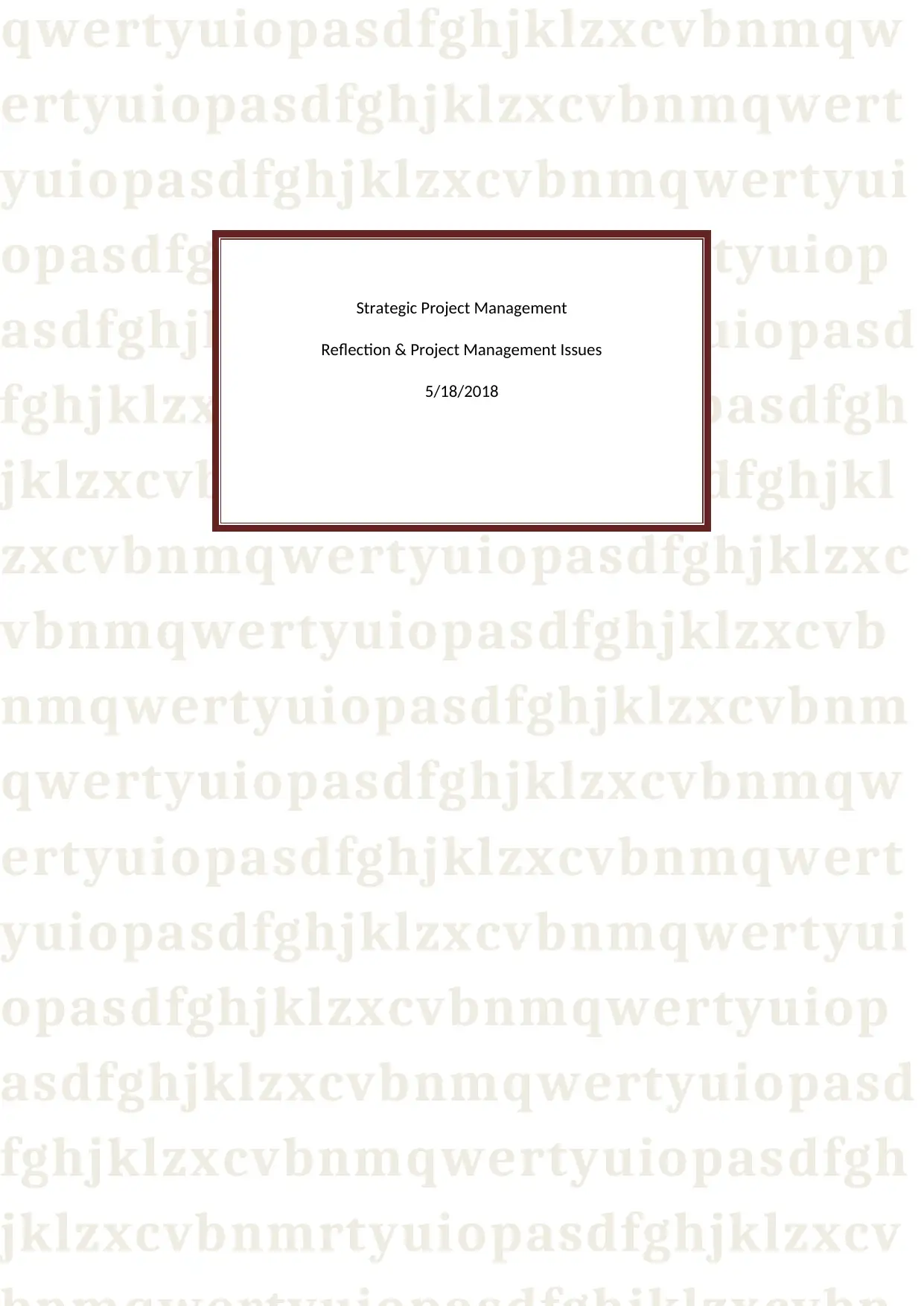
qwertyuiopasdfghjklzxcvbnmqw
ertyuiopasdfghjklzxcvbnmqwert
yuiopasdfghjklzxcvbnmqwertyui
opasdfghjklzxcvbnmqwertyuiop
asdfghjklzxcvbnmqwertyuiopasd
fghjklzxcvbnmqwertyuiopasdfgh
jklzxcvbnmqwertyuiopasdfghjkl
zxcvbnmqwertyuiopasdfghjklzxc
vbnmqwertyuiopasdfghjklzxcvb
nmqwertyuiopasdfghjklzxcvbnm
qwertyuiopasdfghjklzxcvbnmqw
ertyuiopasdfghjklzxcvbnmqwert
yuiopasdfghjklzxcvbnmqwertyui
opasdfghjklzxcvbnmqwertyuiop
asdfghjklzxcvbnmqwertyuiopasd
fghjklzxcvbnmqwertyuiopasdfgh
jklzxcvbnmrtyuiopasdfghjklzxcv
Strategic Project Management
Reflection & Project Management Issues
5/18/2018
ertyuiopasdfghjklzxcvbnmqwert
yuiopasdfghjklzxcvbnmqwertyui
opasdfghjklzxcvbnmqwertyuiop
asdfghjklzxcvbnmqwertyuiopasd
fghjklzxcvbnmqwertyuiopasdfgh
jklzxcvbnmqwertyuiopasdfghjkl
zxcvbnmqwertyuiopasdfghjklzxc
vbnmqwertyuiopasdfghjklzxcvb
nmqwertyuiopasdfghjklzxcvbnm
qwertyuiopasdfghjklzxcvbnmqw
ertyuiopasdfghjklzxcvbnmqwert
yuiopasdfghjklzxcvbnmqwertyui
opasdfghjklzxcvbnmqwertyuiop
asdfghjklzxcvbnmqwertyuiopasd
fghjklzxcvbnmqwertyuiopasdfgh
jklzxcvbnmrtyuiopasdfghjklzxcv
Strategic Project Management
Reflection & Project Management Issues
5/18/2018
Paraphrase This Document
Need a fresh take? Get an instant paraphrase of this document with our AI Paraphraser
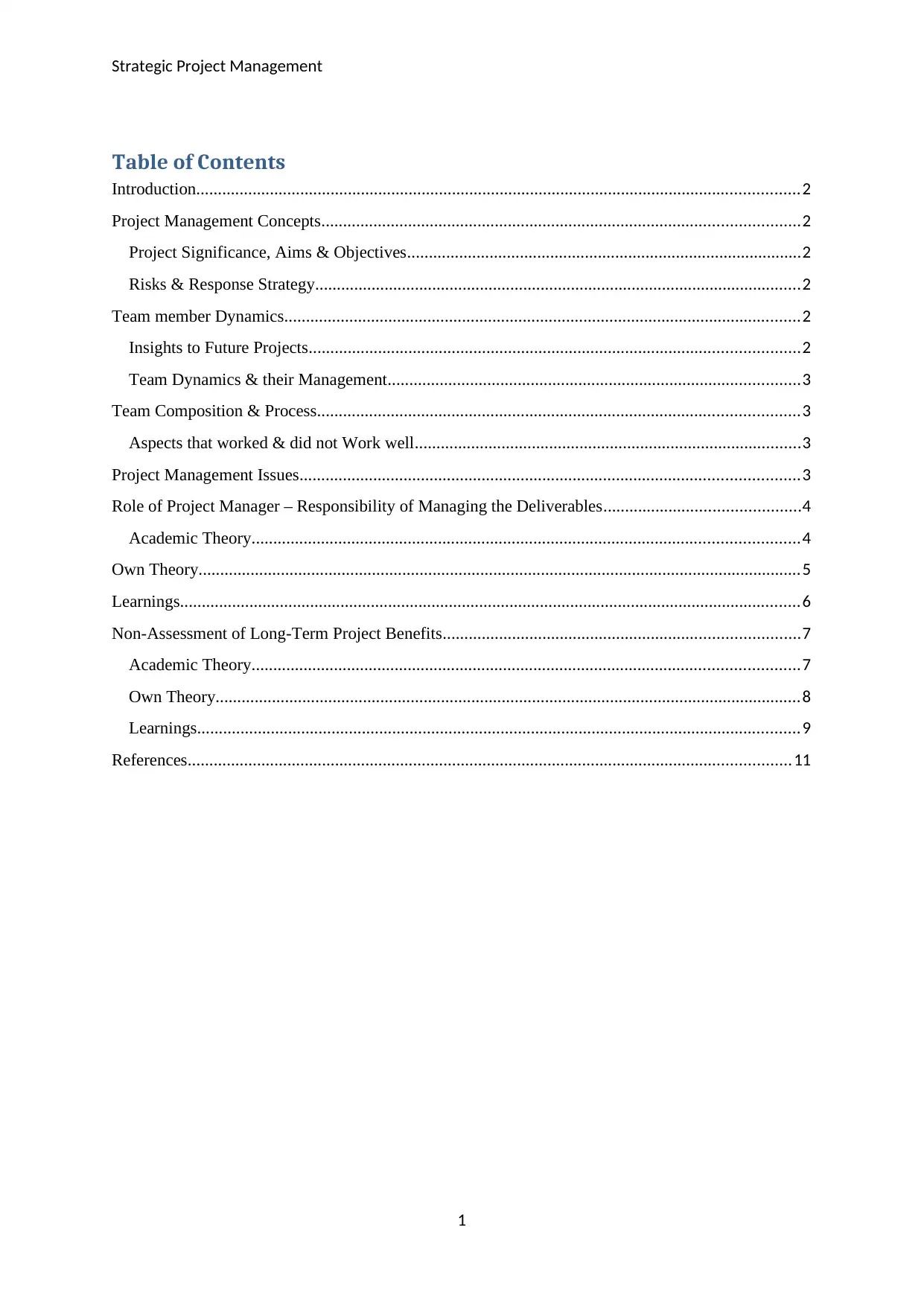
Strategic Project Management
Table of Contents
Introduction...........................................................................................................................................2
Project Management Concepts..............................................................................................................2
Project Significance, Aims & Objectives...........................................................................................2
Risks & Response Strategy................................................................................................................2
Team member Dynamics.......................................................................................................................2
Insights to Future Projects.................................................................................................................2
Team Dynamics & their Management...............................................................................................3
Team Composition & Process...............................................................................................................3
Aspects that worked & did not Work well.........................................................................................3
Project Management Issues...................................................................................................................3
Role of Project Manager – Responsibility of Managing the Deliverables.............................................4
Academic Theory..............................................................................................................................4
Own Theory...........................................................................................................................................5
Learnings...............................................................................................................................................6
Non-Assessment of Long-Term Project Benefits..................................................................................7
Academic Theory..............................................................................................................................7
Own Theory.......................................................................................................................................8
Learnings...........................................................................................................................................9
References...........................................................................................................................................11
1
Table of Contents
Introduction...........................................................................................................................................2
Project Management Concepts..............................................................................................................2
Project Significance, Aims & Objectives...........................................................................................2
Risks & Response Strategy................................................................................................................2
Team member Dynamics.......................................................................................................................2
Insights to Future Projects.................................................................................................................2
Team Dynamics & their Management...............................................................................................3
Team Composition & Process...............................................................................................................3
Aspects that worked & did not Work well.........................................................................................3
Project Management Issues...................................................................................................................3
Role of Project Manager – Responsibility of Managing the Deliverables.............................................4
Academic Theory..............................................................................................................................4
Own Theory...........................................................................................................................................5
Learnings...............................................................................................................................................6
Non-Assessment of Long-Term Project Benefits..................................................................................7
Academic Theory..............................................................................................................................7
Own Theory.......................................................................................................................................8
Learnings...........................................................................................................................................9
References...........................................................................................................................................11
1
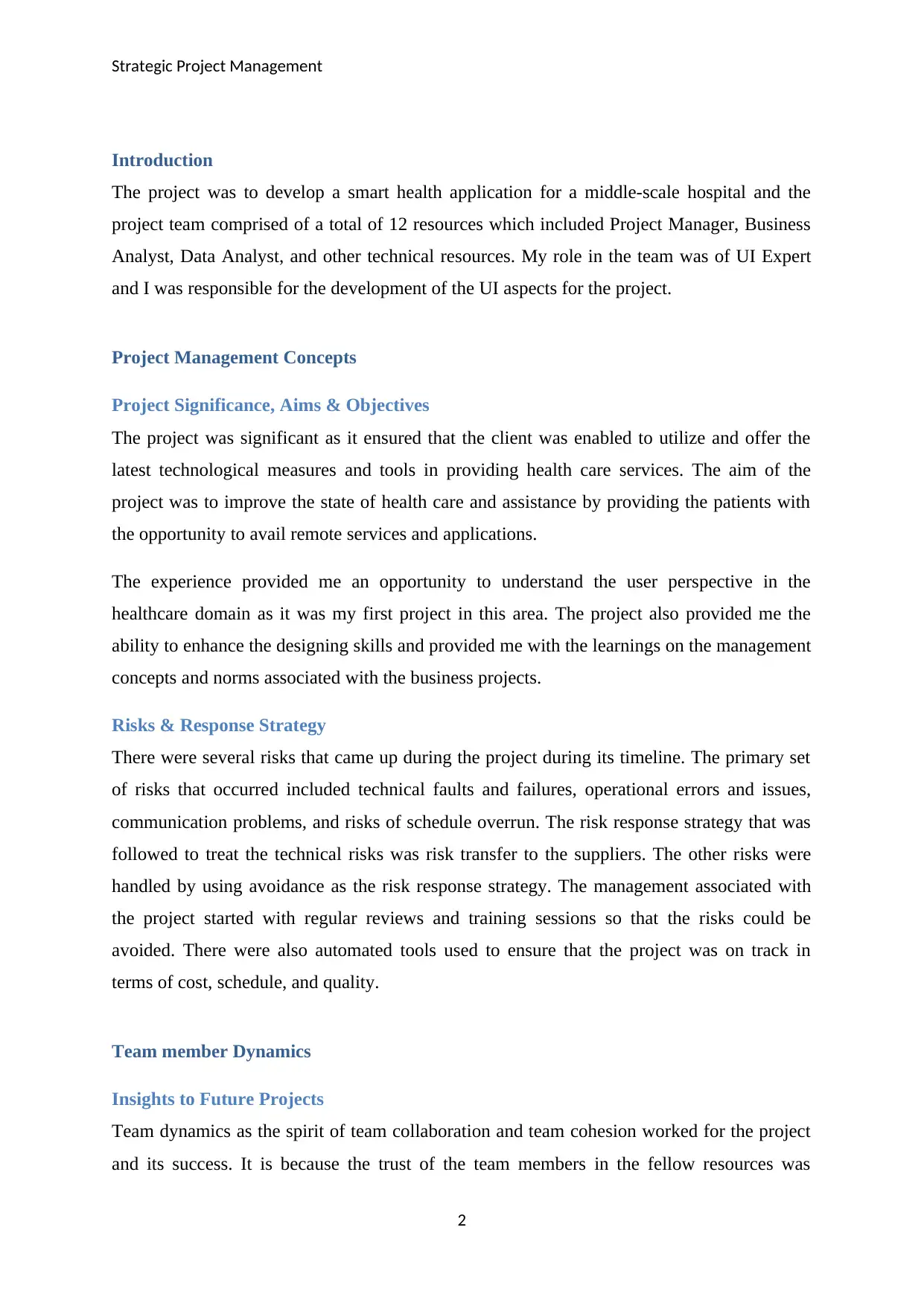
Strategic Project Management
Introduction
The project was to develop a smart health application for a middle-scale hospital and the
project team comprised of a total of 12 resources which included Project Manager, Business
Analyst, Data Analyst, and other technical resources. My role in the team was of UI Expert
and I was responsible for the development of the UI aspects for the project.
Project Management Concepts
Project Significance, Aims & Objectives
The project was significant as it ensured that the client was enabled to utilize and offer the
latest technological measures and tools in providing health care services. The aim of the
project was to improve the state of health care and assistance by providing the patients with
the opportunity to avail remote services and applications.
The experience provided me an opportunity to understand the user perspective in the
healthcare domain as it was my first project in this area. The project also provided me the
ability to enhance the designing skills and provided me with the learnings on the management
concepts and norms associated with the business projects.
Risks & Response Strategy
There were several risks that came up during the project during its timeline. The primary set
of risks that occurred included technical faults and failures, operational errors and issues,
communication problems, and risks of schedule overrun. The risk response strategy that was
followed to treat the technical risks was risk transfer to the suppliers. The other risks were
handled by using avoidance as the risk response strategy. The management associated with
the project started with regular reviews and training sessions so that the risks could be
avoided. There were also automated tools used to ensure that the project was on track in
terms of cost, schedule, and quality.
Team member Dynamics
Insights to Future Projects
Team dynamics as the spirit of team collaboration and team cohesion worked for the project
and its success. It is because the trust of the team members in the fellow resources was
2
Introduction
The project was to develop a smart health application for a middle-scale hospital and the
project team comprised of a total of 12 resources which included Project Manager, Business
Analyst, Data Analyst, and other technical resources. My role in the team was of UI Expert
and I was responsible for the development of the UI aspects for the project.
Project Management Concepts
Project Significance, Aims & Objectives
The project was significant as it ensured that the client was enabled to utilize and offer the
latest technological measures and tools in providing health care services. The aim of the
project was to improve the state of health care and assistance by providing the patients with
the opportunity to avail remote services and applications.
The experience provided me an opportunity to understand the user perspective in the
healthcare domain as it was my first project in this area. The project also provided me the
ability to enhance the designing skills and provided me with the learnings on the management
concepts and norms associated with the business projects.
Risks & Response Strategy
There were several risks that came up during the project during its timeline. The primary set
of risks that occurred included technical faults and failures, operational errors and issues,
communication problems, and risks of schedule overrun. The risk response strategy that was
followed to treat the technical risks was risk transfer to the suppliers. The other risks were
handled by using avoidance as the risk response strategy. The management associated with
the project started with regular reviews and training sessions so that the risks could be
avoided. There were also automated tools used to ensure that the project was on track in
terms of cost, schedule, and quality.
Team member Dynamics
Insights to Future Projects
Team dynamics as the spirit of team collaboration and team cohesion worked for the project
and its success. It is because the trust of the team members in the fellow resources was
2
⊘ This is a preview!⊘
Do you want full access?
Subscribe today to unlock all pages.

Trusted by 1+ million students worldwide
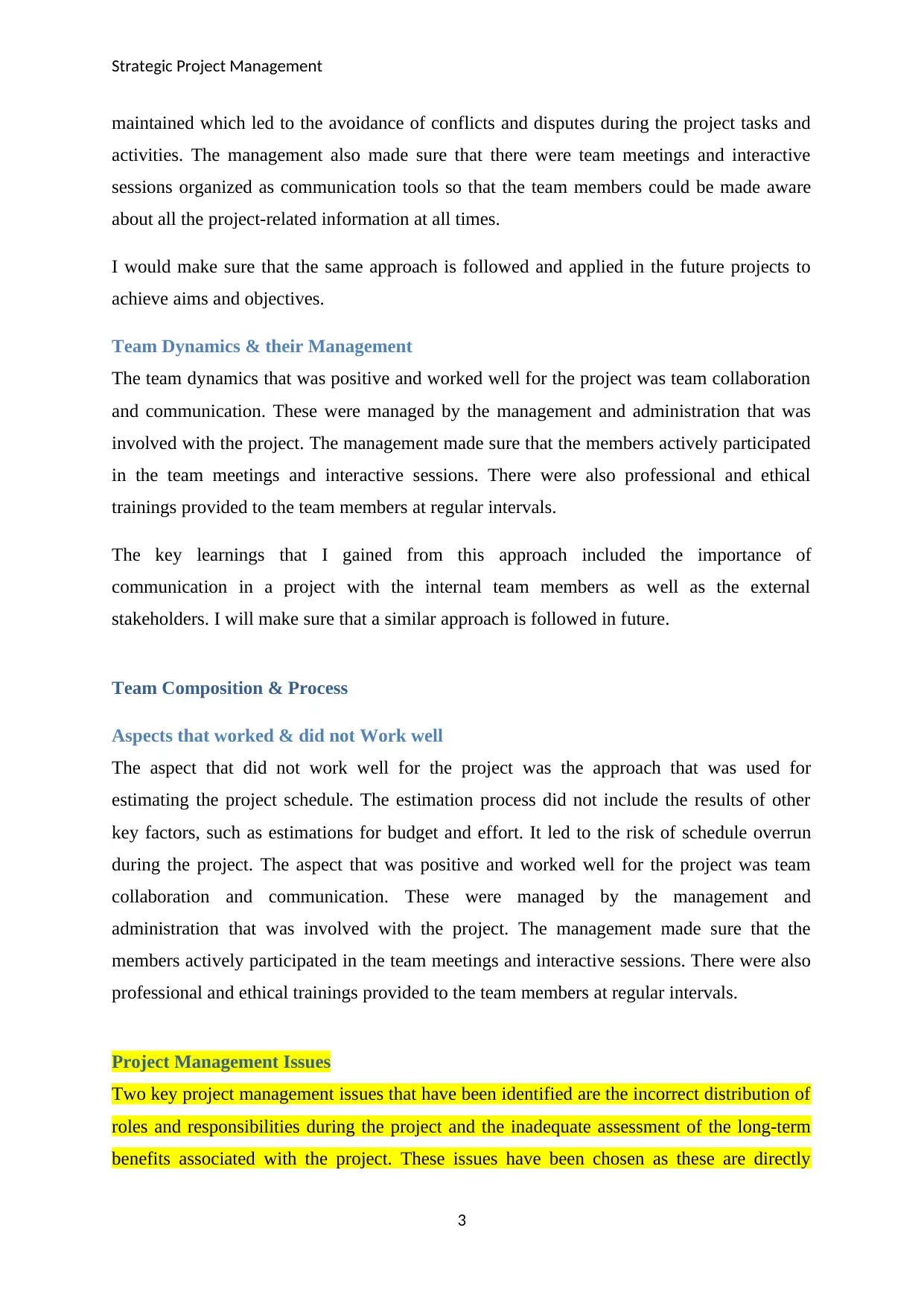
Strategic Project Management
maintained which led to the avoidance of conflicts and disputes during the project tasks and
activities. The management also made sure that there were team meetings and interactive
sessions organized as communication tools so that the team members could be made aware
about all the project-related information at all times.
I would make sure that the same approach is followed and applied in the future projects to
achieve aims and objectives.
Team Dynamics & their Management
The team dynamics that was positive and worked well for the project was team collaboration
and communication. These were managed by the management and administration that was
involved with the project. The management made sure that the members actively participated
in the team meetings and interactive sessions. There were also professional and ethical
trainings provided to the team members at regular intervals.
The key learnings that I gained from this approach included the importance of
communication in a project with the internal team members as well as the external
stakeholders. I will make sure that a similar approach is followed in future.
Team Composition & Process
Aspects that worked & did not Work well
The aspect that did not work well for the project was the approach that was used for
estimating the project schedule. The estimation process did not include the results of other
key factors, such as estimations for budget and effort. It led to the risk of schedule overrun
during the project. The aspect that was positive and worked well for the project was team
collaboration and communication. These were managed by the management and
administration that was involved with the project. The management made sure that the
members actively participated in the team meetings and interactive sessions. There were also
professional and ethical trainings provided to the team members at regular intervals.
Project Management Issues
Two key project management issues that have been identified are the incorrect distribution of
roles and responsibilities during the project and the inadequate assessment of the long-term
benefits associated with the project. These issues have been chosen as these are directly
3
maintained which led to the avoidance of conflicts and disputes during the project tasks and
activities. The management also made sure that there were team meetings and interactive
sessions organized as communication tools so that the team members could be made aware
about all the project-related information at all times.
I would make sure that the same approach is followed and applied in the future projects to
achieve aims and objectives.
Team Dynamics & their Management
The team dynamics that was positive and worked well for the project was team collaboration
and communication. These were managed by the management and administration that was
involved with the project. The management made sure that the members actively participated
in the team meetings and interactive sessions. There were also professional and ethical
trainings provided to the team members at regular intervals.
The key learnings that I gained from this approach included the importance of
communication in a project with the internal team members as well as the external
stakeholders. I will make sure that a similar approach is followed in future.
Team Composition & Process
Aspects that worked & did not Work well
The aspect that did not work well for the project was the approach that was used for
estimating the project schedule. The estimation process did not include the results of other
key factors, such as estimations for budget and effort. It led to the risk of schedule overrun
during the project. The aspect that was positive and worked well for the project was team
collaboration and communication. These were managed by the management and
administration that was involved with the project. The management made sure that the
members actively participated in the team meetings and interactive sessions. There were also
professional and ethical trainings provided to the team members at regular intervals.
Project Management Issues
Two key project management issues that have been identified are the incorrect distribution of
roles and responsibilities during the project and the inadequate assessment of the long-term
benefits associated with the project. These issues have been chosen as these are directly
3
Paraphrase This Document
Need a fresh take? Get an instant paraphrase of this document with our AI Paraphraser
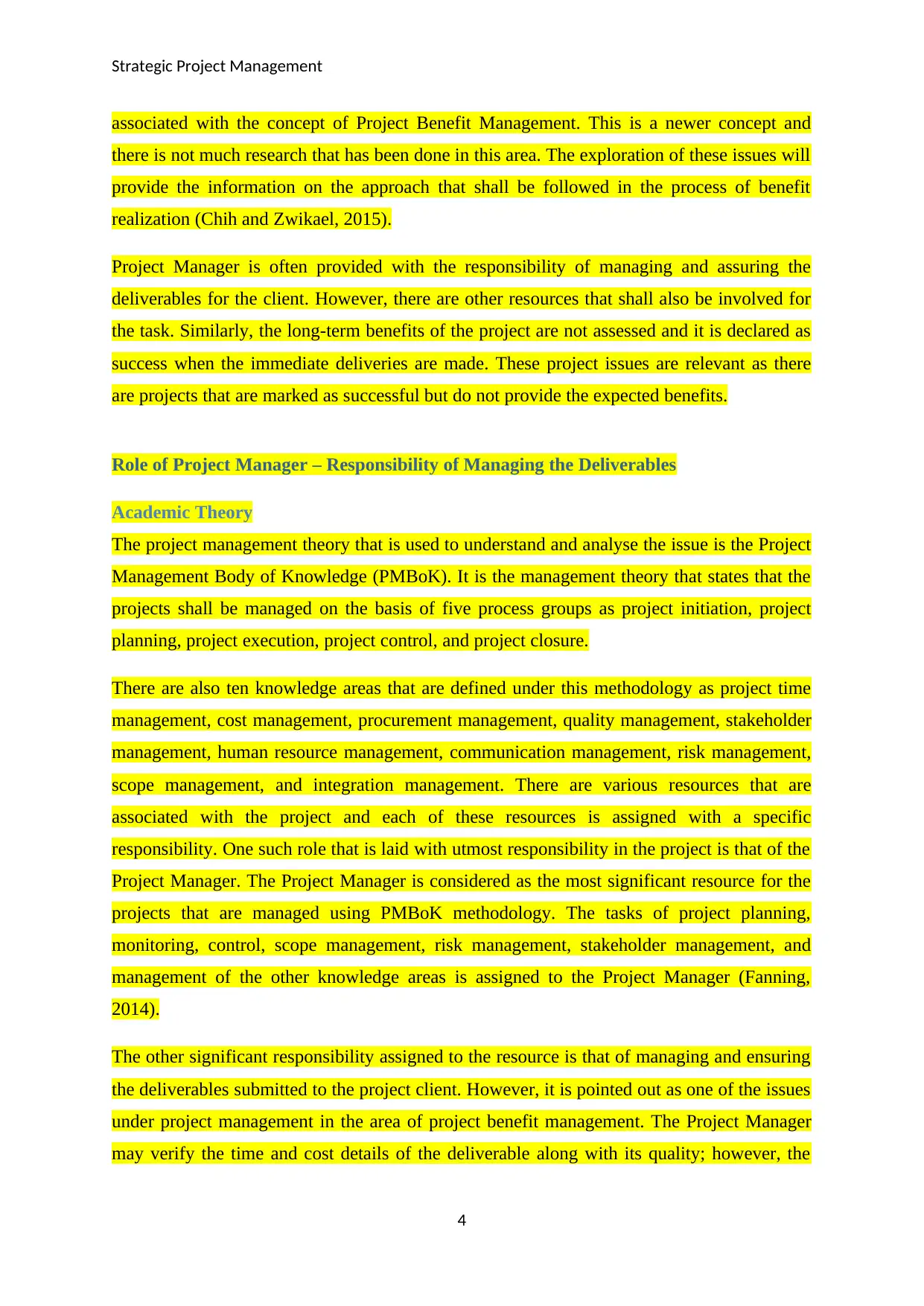
Strategic Project Management
associated with the concept of Project Benefit Management. This is a newer concept and
there is not much research that has been done in this area. The exploration of these issues will
provide the information on the approach that shall be followed in the process of benefit
realization (Chih and Zwikael, 2015).
Project Manager is often provided with the responsibility of managing and assuring the
deliverables for the client. However, there are other resources that shall also be involved for
the task. Similarly, the long-term benefits of the project are not assessed and it is declared as
success when the immediate deliveries are made. These project issues are relevant as there
are projects that are marked as successful but do not provide the expected benefits.
Role of Project Manager – Responsibility of Managing the Deliverables
Academic Theory
The project management theory that is used to understand and analyse the issue is the Project
Management Body of Knowledge (PMBoK). It is the management theory that states that the
projects shall be managed on the basis of five process groups as project initiation, project
planning, project execution, project control, and project closure.
There are also ten knowledge areas that are defined under this methodology as project time
management, cost management, procurement management, quality management, stakeholder
management, human resource management, communication management, risk management,
scope management, and integration management. There are various resources that are
associated with the project and each of these resources is assigned with a specific
responsibility. One such role that is laid with utmost responsibility in the project is that of the
Project Manager. The Project Manager is considered as the most significant resource for the
projects that are managed using PMBoK methodology. The tasks of project planning,
monitoring, control, scope management, risk management, stakeholder management, and
management of the other knowledge areas is assigned to the Project Manager (Fanning,
2014).
The other significant responsibility assigned to the resource is that of managing and ensuring
the deliverables submitted to the project client. However, it is pointed out as one of the issues
under project management in the area of project benefit management. The Project Manager
may verify the time and cost details of the deliverable along with its quality; however, the
4
associated with the concept of Project Benefit Management. This is a newer concept and
there is not much research that has been done in this area. The exploration of these issues will
provide the information on the approach that shall be followed in the process of benefit
realization (Chih and Zwikael, 2015).
Project Manager is often provided with the responsibility of managing and assuring the
deliverables for the client. However, there are other resources that shall also be involved for
the task. Similarly, the long-term benefits of the project are not assessed and it is declared as
success when the immediate deliveries are made. These project issues are relevant as there
are projects that are marked as successful but do not provide the expected benefits.
Role of Project Manager – Responsibility of Managing the Deliverables
Academic Theory
The project management theory that is used to understand and analyse the issue is the Project
Management Body of Knowledge (PMBoK). It is the management theory that states that the
projects shall be managed on the basis of five process groups as project initiation, project
planning, project execution, project control, and project closure.
There are also ten knowledge areas that are defined under this methodology as project time
management, cost management, procurement management, quality management, stakeholder
management, human resource management, communication management, risk management,
scope management, and integration management. There are various resources that are
associated with the project and each of these resources is assigned with a specific
responsibility. One such role that is laid with utmost responsibility in the project is that of the
Project Manager. The Project Manager is considered as the most significant resource for the
projects that are managed using PMBoK methodology. The tasks of project planning,
monitoring, control, scope management, risk management, stakeholder management, and
management of the other knowledge areas is assigned to the Project Manager (Fanning,
2014).
The other significant responsibility assigned to the resource is that of managing and ensuring
the deliverables submitted to the project client. However, it is pointed out as one of the issues
under project management in the area of project benefit management. The Project Manager
may verify the time and cost details of the deliverable along with its quality; however, the
4
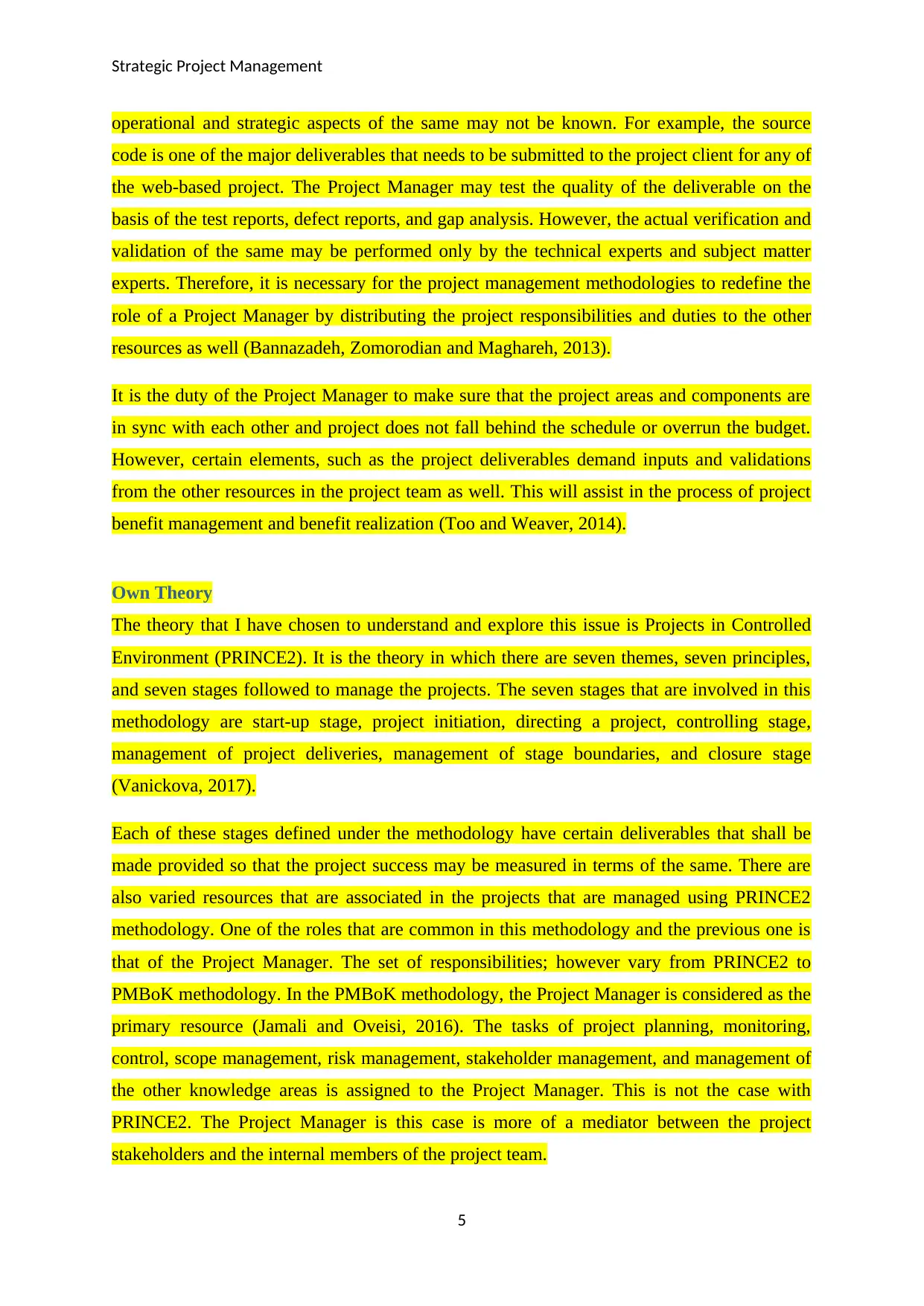
Strategic Project Management
operational and strategic aspects of the same may not be known. For example, the source
code is one of the major deliverables that needs to be submitted to the project client for any of
the web-based project. The Project Manager may test the quality of the deliverable on the
basis of the test reports, defect reports, and gap analysis. However, the actual verification and
validation of the same may be performed only by the technical experts and subject matter
experts. Therefore, it is necessary for the project management methodologies to redefine the
role of a Project Manager by distributing the project responsibilities and duties to the other
resources as well (Bannazadeh, Zomorodian and Maghareh, 2013).
It is the duty of the Project Manager to make sure that the project areas and components are
in sync with each other and project does not fall behind the schedule or overrun the budget.
However, certain elements, such as the project deliverables demand inputs and validations
from the other resources in the project team as well. This will assist in the process of project
benefit management and benefit realization (Too and Weaver, 2014).
Own Theory
The theory that I have chosen to understand and explore this issue is Projects in Controlled
Environment (PRINCE2). It is the theory in which there are seven themes, seven principles,
and seven stages followed to manage the projects. The seven stages that are involved in this
methodology are start-up stage, project initiation, directing a project, controlling stage,
management of project deliveries, management of stage boundaries, and closure stage
(Vanickova, 2017).
Each of these stages defined under the methodology have certain deliverables that shall be
made provided so that the project success may be measured in terms of the same. There are
also varied resources that are associated in the projects that are managed using PRINCE2
methodology. One of the roles that are common in this methodology and the previous one is
that of the Project Manager. The set of responsibilities; however vary from PRINCE2 to
PMBoK methodology. In the PMBoK methodology, the Project Manager is considered as the
primary resource (Jamali and Oveisi, 2016). The tasks of project planning, monitoring,
control, scope management, risk management, stakeholder management, and management of
the other knowledge areas is assigned to the Project Manager. This is not the case with
PRINCE2. The Project Manager is this case is more of a mediator between the project
stakeholders and the internal members of the project team.
5
operational and strategic aspects of the same may not be known. For example, the source
code is one of the major deliverables that needs to be submitted to the project client for any of
the web-based project. The Project Manager may test the quality of the deliverable on the
basis of the test reports, defect reports, and gap analysis. However, the actual verification and
validation of the same may be performed only by the technical experts and subject matter
experts. Therefore, it is necessary for the project management methodologies to redefine the
role of a Project Manager by distributing the project responsibilities and duties to the other
resources as well (Bannazadeh, Zomorodian and Maghareh, 2013).
It is the duty of the Project Manager to make sure that the project areas and components are
in sync with each other and project does not fall behind the schedule or overrun the budget.
However, certain elements, such as the project deliverables demand inputs and validations
from the other resources in the project team as well. This will assist in the process of project
benefit management and benefit realization (Too and Weaver, 2014).
Own Theory
The theory that I have chosen to understand and explore this issue is Projects in Controlled
Environment (PRINCE2). It is the theory in which there are seven themes, seven principles,
and seven stages followed to manage the projects. The seven stages that are involved in this
methodology are start-up stage, project initiation, directing a project, controlling stage,
management of project deliveries, management of stage boundaries, and closure stage
(Vanickova, 2017).
Each of these stages defined under the methodology have certain deliverables that shall be
made provided so that the project success may be measured in terms of the same. There are
also varied resources that are associated in the projects that are managed using PRINCE2
methodology. One of the roles that are common in this methodology and the previous one is
that of the Project Manager. The set of responsibilities; however vary from PRINCE2 to
PMBoK methodology. In the PMBoK methodology, the Project Manager is considered as the
primary resource (Jamali and Oveisi, 2016). The tasks of project planning, monitoring,
control, scope management, risk management, stakeholder management, and management of
the other knowledge areas is assigned to the Project Manager. This is not the case with
PRINCE2. The Project Manager is this case is more of a mediator between the project
stakeholders and the internal members of the project team.
5
⊘ This is a preview!⊘
Do you want full access?
Subscribe today to unlock all pages.

Trusted by 1+ million students worldwide
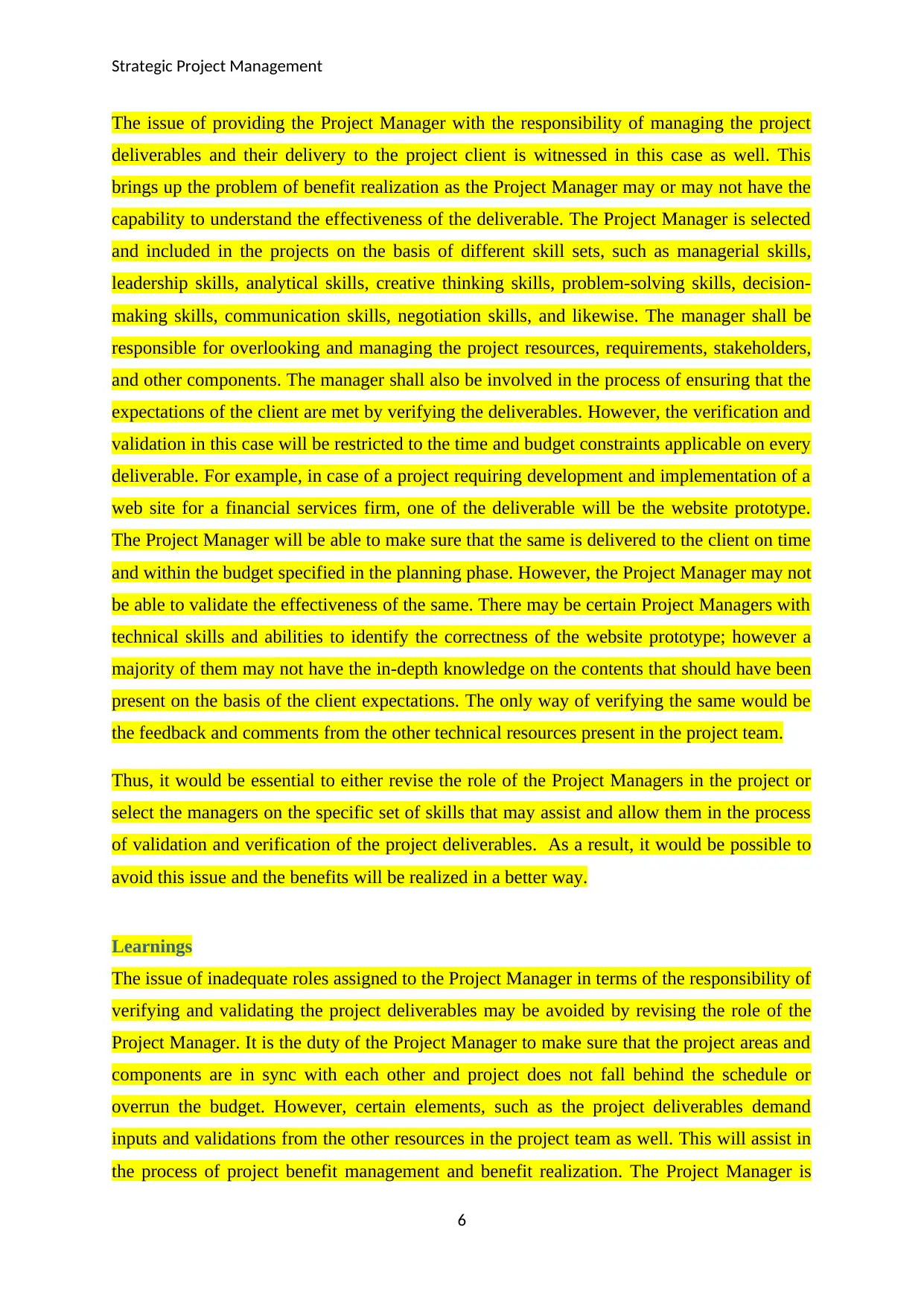
Strategic Project Management
The issue of providing the Project Manager with the responsibility of managing the project
deliverables and their delivery to the project client is witnessed in this case as well. This
brings up the problem of benefit realization as the Project Manager may or may not have the
capability to understand the effectiveness of the deliverable. The Project Manager is selected
and included in the projects on the basis of different skill sets, such as managerial skills,
leadership skills, analytical skills, creative thinking skills, problem-solving skills, decision-
making skills, communication skills, negotiation skills, and likewise. The manager shall be
responsible for overlooking and managing the project resources, requirements, stakeholders,
and other components. The manager shall also be involved in the process of ensuring that the
expectations of the client are met by verifying the deliverables. However, the verification and
validation in this case will be restricted to the time and budget constraints applicable on every
deliverable. For example, in case of a project requiring development and implementation of a
web site for a financial services firm, one of the deliverable will be the website prototype.
The Project Manager will be able to make sure that the same is delivered to the client on time
and within the budget specified in the planning phase. However, the Project Manager may not
be able to validate the effectiveness of the same. There may be certain Project Managers with
technical skills and abilities to identify the correctness of the website prototype; however a
majority of them may not have the in-depth knowledge on the contents that should have been
present on the basis of the client expectations. The only way of verifying the same would be
the feedback and comments from the other technical resources present in the project team.
Thus, it would be essential to either revise the role of the Project Managers in the project or
select the managers on the specific set of skills that may assist and allow them in the process
of validation and verification of the project deliverables. As a result, it would be possible to
avoid this issue and the benefits will be realized in a better way.
Learnings
The issue of inadequate roles assigned to the Project Manager in terms of the responsibility of
verifying and validating the project deliverables may be avoided by revising the role of the
Project Manager. It is the duty of the Project Manager to make sure that the project areas and
components are in sync with each other and project does not fall behind the schedule or
overrun the budget. However, certain elements, such as the project deliverables demand
inputs and validations from the other resources in the project team as well. This will assist in
the process of project benefit management and benefit realization. The Project Manager is
6
The issue of providing the Project Manager with the responsibility of managing the project
deliverables and their delivery to the project client is witnessed in this case as well. This
brings up the problem of benefit realization as the Project Manager may or may not have the
capability to understand the effectiveness of the deliverable. The Project Manager is selected
and included in the projects on the basis of different skill sets, such as managerial skills,
leadership skills, analytical skills, creative thinking skills, problem-solving skills, decision-
making skills, communication skills, negotiation skills, and likewise. The manager shall be
responsible for overlooking and managing the project resources, requirements, stakeholders,
and other components. The manager shall also be involved in the process of ensuring that the
expectations of the client are met by verifying the deliverables. However, the verification and
validation in this case will be restricted to the time and budget constraints applicable on every
deliverable. For example, in case of a project requiring development and implementation of a
web site for a financial services firm, one of the deliverable will be the website prototype.
The Project Manager will be able to make sure that the same is delivered to the client on time
and within the budget specified in the planning phase. However, the Project Manager may not
be able to validate the effectiveness of the same. There may be certain Project Managers with
technical skills and abilities to identify the correctness of the website prototype; however a
majority of them may not have the in-depth knowledge on the contents that should have been
present on the basis of the client expectations. The only way of verifying the same would be
the feedback and comments from the other technical resources present in the project team.
Thus, it would be essential to either revise the role of the Project Managers in the project or
select the managers on the specific set of skills that may assist and allow them in the process
of validation and verification of the project deliverables. As a result, it would be possible to
avoid this issue and the benefits will be realized in a better way.
Learnings
The issue of inadequate roles assigned to the Project Manager in terms of the responsibility of
verifying and validating the project deliverables may be avoided by revising the role of the
Project Manager. It is the duty of the Project Manager to make sure that the project areas and
components are in sync with each other and project does not fall behind the schedule or
overrun the budget. However, certain elements, such as the project deliverables demand
inputs and validations from the other resources in the project team as well. This will assist in
the process of project benefit management and benefit realization. The Project Manager is
6
Paraphrase This Document
Need a fresh take? Get an instant paraphrase of this document with our AI Paraphraser
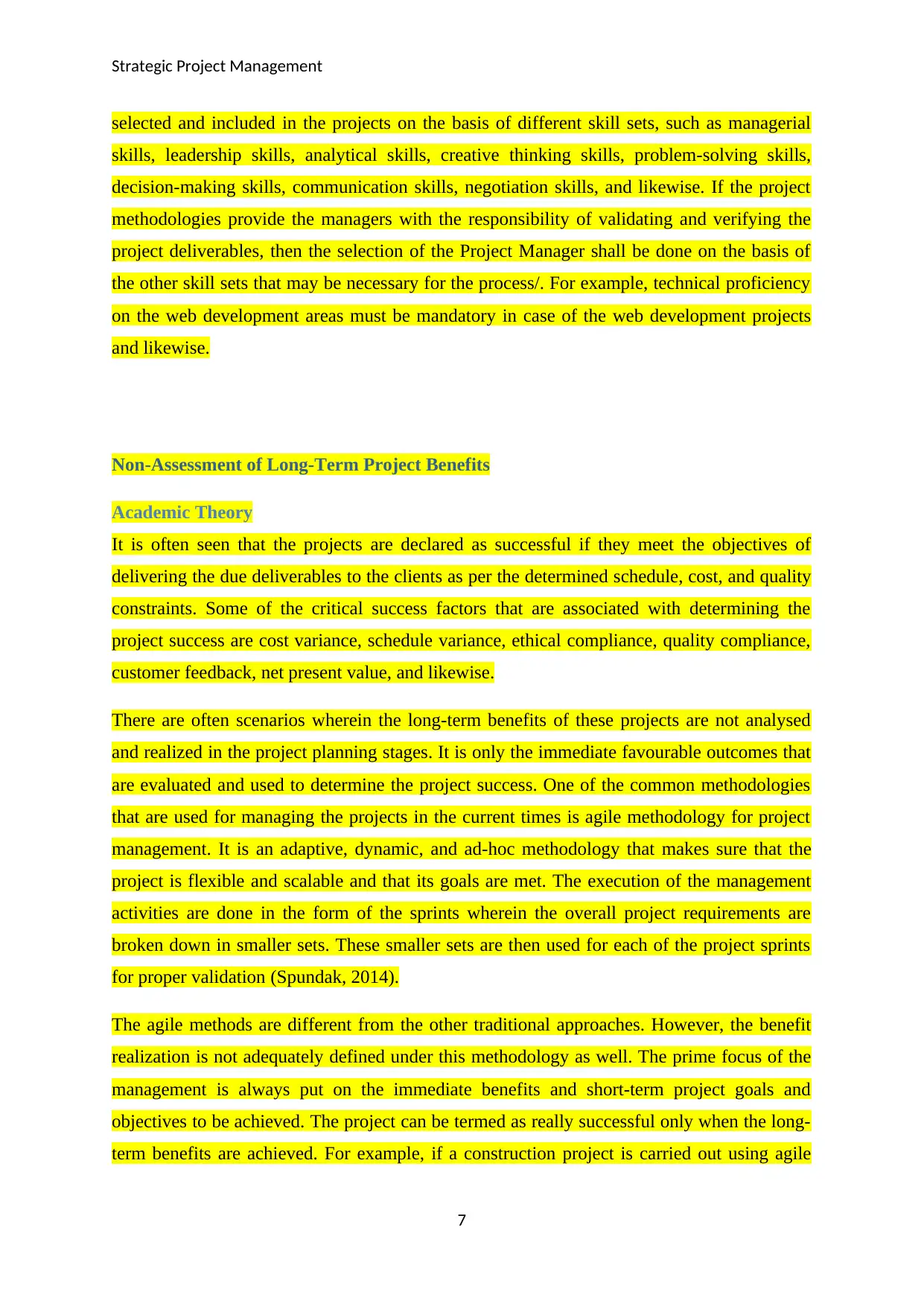
Strategic Project Management
selected and included in the projects on the basis of different skill sets, such as managerial
skills, leadership skills, analytical skills, creative thinking skills, problem-solving skills,
decision-making skills, communication skills, negotiation skills, and likewise. If the project
methodologies provide the managers with the responsibility of validating and verifying the
project deliverables, then the selection of the Project Manager shall be done on the basis of
the other skill sets that may be necessary for the process/. For example, technical proficiency
on the web development areas must be mandatory in case of the web development projects
and likewise.
Non-Assessment of Long-Term Project Benefits
Academic Theory
It is often seen that the projects are declared as successful if they meet the objectives of
delivering the due deliverables to the clients as per the determined schedule, cost, and quality
constraints. Some of the critical success factors that are associated with determining the
project success are cost variance, schedule variance, ethical compliance, quality compliance,
customer feedback, net present value, and likewise.
There are often scenarios wherein the long-term benefits of these projects are not analysed
and realized in the project planning stages. It is only the immediate favourable outcomes that
are evaluated and used to determine the project success. One of the common methodologies
that are used for managing the projects in the current times is agile methodology for project
management. It is an adaptive, dynamic, and ad-hoc methodology that makes sure that the
project is flexible and scalable and that its goals are met. The execution of the management
activities are done in the form of the sprints wherein the overall project requirements are
broken down in smaller sets. These smaller sets are then used for each of the project sprints
for proper validation (Spundak, 2014).
The agile methods are different from the other traditional approaches. However, the benefit
realization is not adequately defined under this methodology as well. The prime focus of the
management is always put on the immediate benefits and short-term project goals and
objectives to be achieved. The project can be termed as really successful only when the long-
term benefits are achieved. For example, if a construction project is carried out using agile
7
selected and included in the projects on the basis of different skill sets, such as managerial
skills, leadership skills, analytical skills, creative thinking skills, problem-solving skills,
decision-making skills, communication skills, negotiation skills, and likewise. If the project
methodologies provide the managers with the responsibility of validating and verifying the
project deliverables, then the selection of the Project Manager shall be done on the basis of
the other skill sets that may be necessary for the process/. For example, technical proficiency
on the web development areas must be mandatory in case of the web development projects
and likewise.
Non-Assessment of Long-Term Project Benefits
Academic Theory
It is often seen that the projects are declared as successful if they meet the objectives of
delivering the due deliverables to the clients as per the determined schedule, cost, and quality
constraints. Some of the critical success factors that are associated with determining the
project success are cost variance, schedule variance, ethical compliance, quality compliance,
customer feedback, net present value, and likewise.
There are often scenarios wherein the long-term benefits of these projects are not analysed
and realized in the project planning stages. It is only the immediate favourable outcomes that
are evaluated and used to determine the project success. One of the common methodologies
that are used for managing the projects in the current times is agile methodology for project
management. It is an adaptive, dynamic, and ad-hoc methodology that makes sure that the
project is flexible and scalable and that its goals are met. The execution of the management
activities are done in the form of the sprints wherein the overall project requirements are
broken down in smaller sets. These smaller sets are then used for each of the project sprints
for proper validation (Spundak, 2014).
The agile methods are different from the other traditional approaches. However, the benefit
realization is not adequately defined under this methodology as well. The prime focus of the
management is always put on the immediate benefits and short-term project goals and
objectives to be achieved. The project can be termed as really successful only when the long-
term benefits are achieved. For example, if a construction project is carried out using agile
7
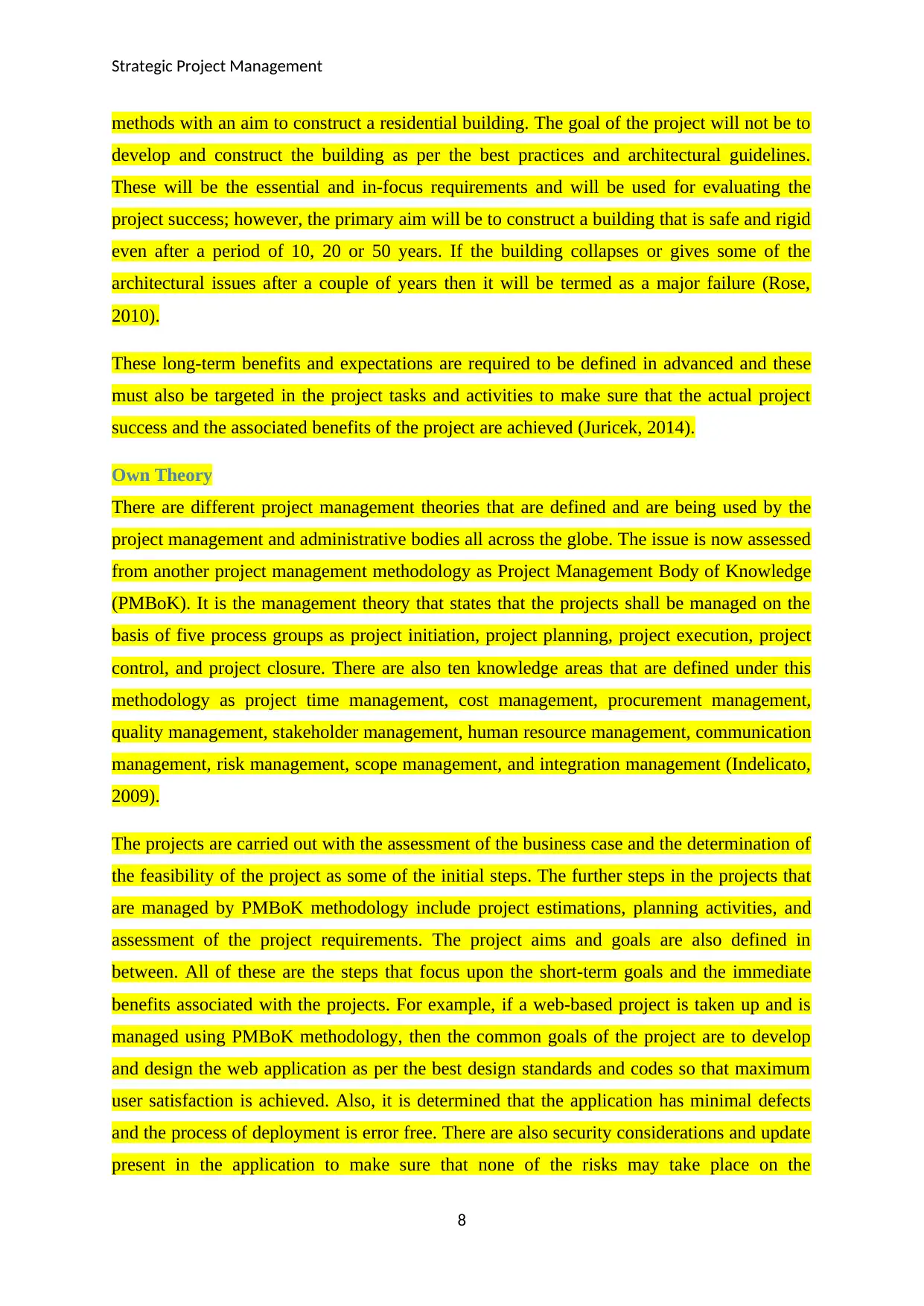
Strategic Project Management
methods with an aim to construct a residential building. The goal of the project will not be to
develop and construct the building as per the best practices and architectural guidelines.
These will be the essential and in-focus requirements and will be used for evaluating the
project success; however, the primary aim will be to construct a building that is safe and rigid
even after a period of 10, 20 or 50 years. If the building collapses or gives some of the
architectural issues after a couple of years then it will be termed as a major failure (Rose,
2010).
These long-term benefits and expectations are required to be defined in advanced and these
must also be targeted in the project tasks and activities to make sure that the actual project
success and the associated benefits of the project are achieved (Juricek, 2014).
Own Theory
There are different project management theories that are defined and are being used by the
project management and administrative bodies all across the globe. The issue is now assessed
from another project management methodology as Project Management Body of Knowledge
(PMBoK). It is the management theory that states that the projects shall be managed on the
basis of five process groups as project initiation, project planning, project execution, project
control, and project closure. There are also ten knowledge areas that are defined under this
methodology as project time management, cost management, procurement management,
quality management, stakeholder management, human resource management, communication
management, risk management, scope management, and integration management (Indelicato,
2009).
The projects are carried out with the assessment of the business case and the determination of
the feasibility of the project as some of the initial steps. The further steps in the projects that
are managed by PMBoK methodology include project estimations, planning activities, and
assessment of the project requirements. The project aims and goals are also defined in
between. All of these are the steps that focus upon the short-term goals and the immediate
benefits associated with the projects. For example, if a web-based project is taken up and is
managed using PMBoK methodology, then the common goals of the project are to develop
and design the web application as per the best design standards and codes so that maximum
user satisfaction is achieved. Also, it is determined that the application has minimal defects
and the process of deployment is error free. There are also security considerations and update
present in the application to make sure that none of the risks may take place on the
8
methods with an aim to construct a residential building. The goal of the project will not be to
develop and construct the building as per the best practices and architectural guidelines.
These will be the essential and in-focus requirements and will be used for evaluating the
project success; however, the primary aim will be to construct a building that is safe and rigid
even after a period of 10, 20 or 50 years. If the building collapses or gives some of the
architectural issues after a couple of years then it will be termed as a major failure (Rose,
2010).
These long-term benefits and expectations are required to be defined in advanced and these
must also be targeted in the project tasks and activities to make sure that the actual project
success and the associated benefits of the project are achieved (Juricek, 2014).
Own Theory
There are different project management theories that are defined and are being used by the
project management and administrative bodies all across the globe. The issue is now assessed
from another project management methodology as Project Management Body of Knowledge
(PMBoK). It is the management theory that states that the projects shall be managed on the
basis of five process groups as project initiation, project planning, project execution, project
control, and project closure. There are also ten knowledge areas that are defined under this
methodology as project time management, cost management, procurement management,
quality management, stakeholder management, human resource management, communication
management, risk management, scope management, and integration management (Indelicato,
2009).
The projects are carried out with the assessment of the business case and the determination of
the feasibility of the project as some of the initial steps. The further steps in the projects that
are managed by PMBoK methodology include project estimations, planning activities, and
assessment of the project requirements. The project aims and goals are also defined in
between. All of these are the steps that focus upon the short-term goals and the immediate
benefits associated with the projects. For example, if a web-based project is taken up and is
managed using PMBoK methodology, then the common goals of the project are to develop
and design the web application as per the best design standards and codes so that maximum
user satisfaction is achieved. Also, it is determined that the application has minimal defects
and the process of deployment is error free. There are also security considerations and update
present in the application to make sure that none of the risks may take place on the
8
⊘ This is a preview!⊘
Do you want full access?
Subscribe today to unlock all pages.

Trusted by 1+ million students worldwide

Strategic Project Management
application. The web application will be termed as successful if the project team succeeds in
providing these deliverables and requirements on time and under the specified budget
(Gomes, 2013). However, if the website does not target the demands of a specific user set or
crashes in the future after few years then the project will be termed as unsuccessful. Also, if
the web site fails to attract the expected number of hits then also it will be termed as a failure.
It is therefore required for the project management to make sure that the goals and objectives
of the project are achieved and the long-term benefits of the project are also met along with
the achievement of the short-term goals.
This may be done by following an alternate approach during the planning and estimation
phase of the project. The cost-benefit analysis is one such scheme that is followed to
determine the future benefits associated with a project. It is necessary to include more such
schemes so that the project benefit realization and management may be achieved. It would
also be necessary to make sure that the future risks and attacks are targeted upon so that the
users may not face any trouble in the years to come. The post-maintenance and support
activities in a project never end and it is the responsibility of the project manager and other
management resources to make sure that the required activities are carried out. These long-
term benefits and expectations are required to be defined in advanced and these must also be
targeted in the project tasks and activities to make sure that the actual project success and the
associated benefits of the project are achieved. This would assist in the process of benefit
realization and will also provide newer mechanisms and measures that may be used in project
benefit management.
Learnings
Project benefit management is a newer concept and there is not much research that has been
done in this area. The exploration of the issues will provide the information on the approach
that shall be followed in the process of benefit realization. The long-term benefits of the
project are not assessed and it is declared as success when the immediate deliveries are made.
It is often seen that the projects are declared as successful if they meet the objectives of
delivering the due deliverables to the clients as per the determined schedule, cost, and quality
constraints. These project issues are relevant as there are projects that are marked as
successful but do not provide the expected benefits. It is necessary to include more schemes
like cost benefit analysis so that the projects benefit realization and management may be
9
application. The web application will be termed as successful if the project team succeeds in
providing these deliverables and requirements on time and under the specified budget
(Gomes, 2013). However, if the website does not target the demands of a specific user set or
crashes in the future after few years then the project will be termed as unsuccessful. Also, if
the web site fails to attract the expected number of hits then also it will be termed as a failure.
It is therefore required for the project management to make sure that the goals and objectives
of the project are achieved and the long-term benefits of the project are also met along with
the achievement of the short-term goals.
This may be done by following an alternate approach during the planning and estimation
phase of the project. The cost-benefit analysis is one such scheme that is followed to
determine the future benefits associated with a project. It is necessary to include more such
schemes so that the project benefit realization and management may be achieved. It would
also be necessary to make sure that the future risks and attacks are targeted upon so that the
users may not face any trouble in the years to come. The post-maintenance and support
activities in a project never end and it is the responsibility of the project manager and other
management resources to make sure that the required activities are carried out. These long-
term benefits and expectations are required to be defined in advanced and these must also be
targeted in the project tasks and activities to make sure that the actual project success and the
associated benefits of the project are achieved. This would assist in the process of benefit
realization and will also provide newer mechanisms and measures that may be used in project
benefit management.
Learnings
Project benefit management is a newer concept and there is not much research that has been
done in this area. The exploration of the issues will provide the information on the approach
that shall be followed in the process of benefit realization. The long-term benefits of the
project are not assessed and it is declared as success when the immediate deliveries are made.
It is often seen that the projects are declared as successful if they meet the objectives of
delivering the due deliverables to the clients as per the determined schedule, cost, and quality
constraints. These project issues are relevant as there are projects that are marked as
successful but do not provide the expected benefits. It is necessary to include more schemes
like cost benefit analysis so that the projects benefit realization and management may be
9
Paraphrase This Document
Need a fresh take? Get an instant paraphrase of this document with our AI Paraphraser

Strategic Project Management
achieved. It would also be necessary to make sure that the future risks and attacks are
targeted upon so that the users may not face any trouble in the years to come. It is also
required for the project management to make sure that the goals and objectives of the project
are achieved and the long-term benefits of the project are also met along with the
achievement of the short-term goals.
10
achieved. It would also be necessary to make sure that the future risks and attacks are
targeted upon so that the users may not face any trouble in the years to come. It is also
required for the project management to make sure that the goals and objectives of the project
are achieved and the long-term benefits of the project are also met along with the
achievement of the short-term goals.
10
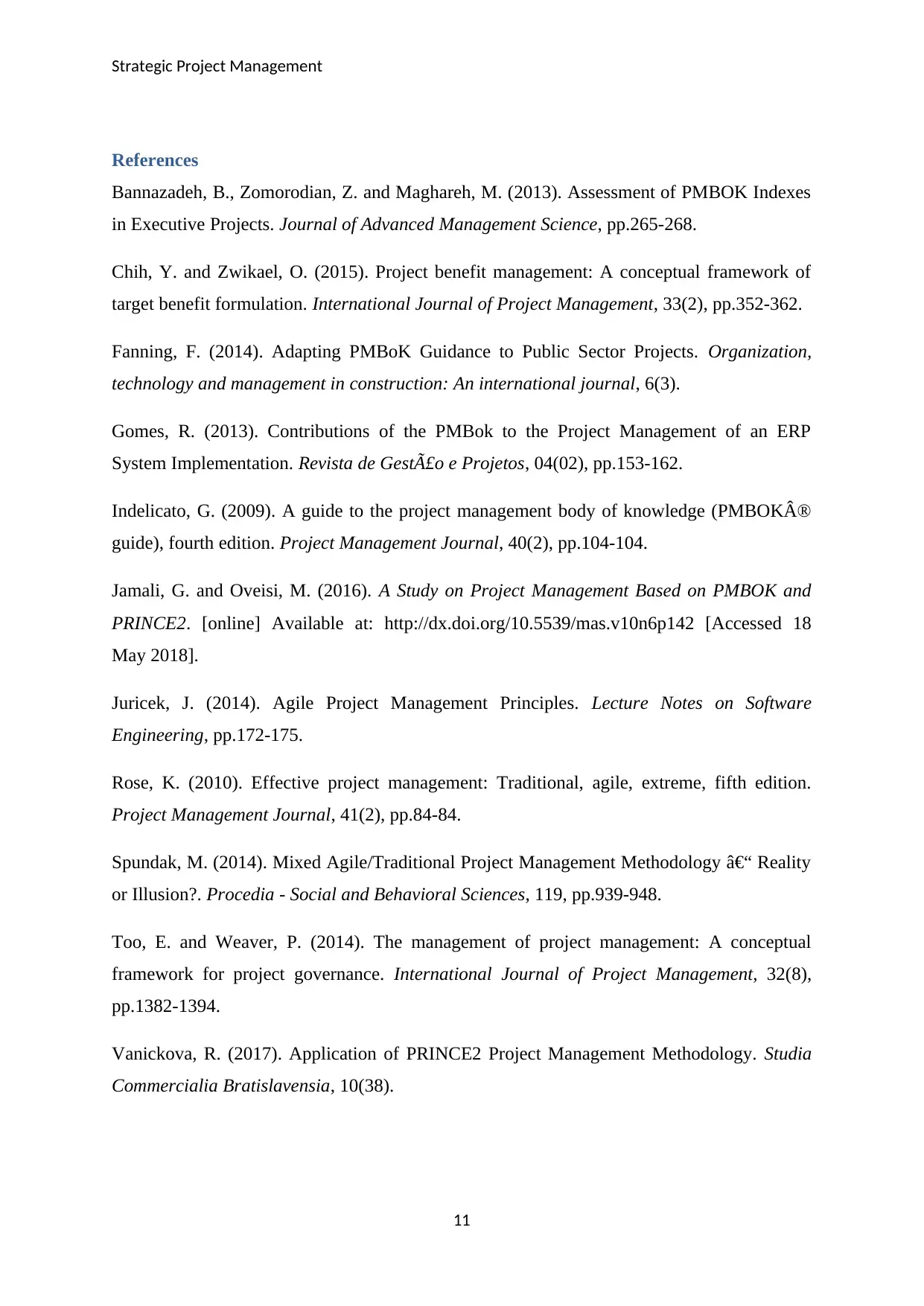
Strategic Project Management
References
Bannazadeh, B., Zomorodian, Z. and Maghareh, M. (2013). Assessment of PMBOK Indexes
in Executive Projects. Journal of Advanced Management Science, pp.265-268.
Chih, Y. and Zwikael, O. (2015). Project benefit management: A conceptual framework of
target benefit formulation. International Journal of Project Management, 33(2), pp.352-362.
Fanning, F. (2014). Adapting PMBoK Guidance to Public Sector Projects. Organization,
technology and management in construction: An international journal, 6(3).
Gomes, R. (2013). Contributions of the PMBok to the Project Management of an ERP
System Implementation. Revista de Gestão e Projetos, 04(02), pp.153-162.
Indelicato, G. (2009). A guide to the project management body of knowledge (PMBOK®
guide), fourth edition. Project Management Journal, 40(2), pp.104-104.
Jamali, G. and Oveisi, M. (2016). A Study on Project Management Based on PMBOK and
PRINCE2. [online] Available at: http://dx.doi.org/10.5539/mas.v10n6p142 [Accessed 18
May 2018].
Juricek, J. (2014). Agile Project Management Principles. Lecture Notes on Software
Engineering, pp.172-175.
Rose, K. (2010). Effective project management: Traditional, agile, extreme, fifth edition.
Project Management Journal, 41(2), pp.84-84.
Spundak, M. (2014). Mixed Agile/Traditional Project Management Methodology – Reality
or Illusion?. Procedia - Social and Behavioral Sciences, 119, pp.939-948.
Too, E. and Weaver, P. (2014). The management of project management: A conceptual
framework for project governance. International Journal of Project Management, 32(8),
pp.1382-1394.
Vanickova, R. (2017). Application of PRINCE2 Project Management Methodology. Studia
Commercialia Bratislavensia, 10(38).
11
References
Bannazadeh, B., Zomorodian, Z. and Maghareh, M. (2013). Assessment of PMBOK Indexes
in Executive Projects. Journal of Advanced Management Science, pp.265-268.
Chih, Y. and Zwikael, O. (2015). Project benefit management: A conceptual framework of
target benefit formulation. International Journal of Project Management, 33(2), pp.352-362.
Fanning, F. (2014). Adapting PMBoK Guidance to Public Sector Projects. Organization,
technology and management in construction: An international journal, 6(3).
Gomes, R. (2013). Contributions of the PMBok to the Project Management of an ERP
System Implementation. Revista de Gestão e Projetos, 04(02), pp.153-162.
Indelicato, G. (2009). A guide to the project management body of knowledge (PMBOK®
guide), fourth edition. Project Management Journal, 40(2), pp.104-104.
Jamali, G. and Oveisi, M. (2016). A Study on Project Management Based on PMBOK and
PRINCE2. [online] Available at: http://dx.doi.org/10.5539/mas.v10n6p142 [Accessed 18
May 2018].
Juricek, J. (2014). Agile Project Management Principles. Lecture Notes on Software
Engineering, pp.172-175.
Rose, K. (2010). Effective project management: Traditional, agile, extreme, fifth edition.
Project Management Journal, 41(2), pp.84-84.
Spundak, M. (2014). Mixed Agile/Traditional Project Management Methodology – Reality
or Illusion?. Procedia - Social and Behavioral Sciences, 119, pp.939-948.
Too, E. and Weaver, P. (2014). The management of project management: A conceptual
framework for project governance. International Journal of Project Management, 32(8),
pp.1382-1394.
Vanickova, R. (2017). Application of PRINCE2 Project Management Methodology. Studia
Commercialia Bratislavensia, 10(38).
11
⊘ This is a preview!⊘
Do you want full access?
Subscribe today to unlock all pages.

Trusted by 1+ million students worldwide
1 out of 12
Related Documents
Your All-in-One AI-Powered Toolkit for Academic Success.
+13062052269
info@desklib.com
Available 24*7 on WhatsApp / Email
![[object Object]](/_next/static/media/star-bottom.7253800d.svg)
Unlock your academic potential
Copyright © 2020–2025 A2Z Services. All Rights Reserved. Developed and managed by ZUCOL.




